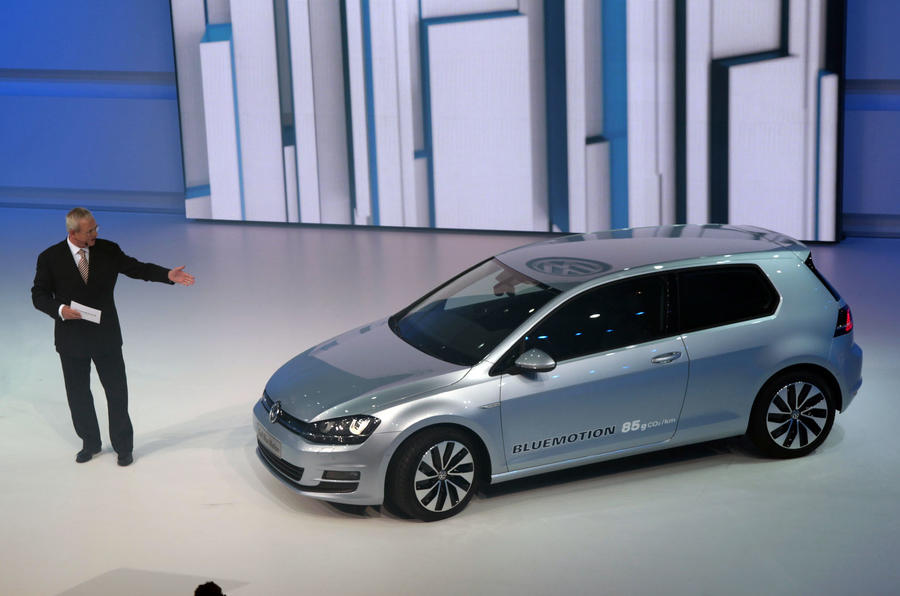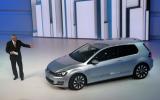Here is the Mk7 Volkswagen Golf, an all-new design said to be lighter, roomier, safer and more economical than the outgoing model.
The sharp appearance, high-quality interior and class-leading safety features of the crucial 2013 Volkswagen Golf at the car’s public unveiling at the Paris motor show.
VW chairman Martin Winterkorn confirmed that the new Golf is significantly lighter than the sixth-generation model it replaces, despite a moderate increase in size and higher levels of standard equipment. “We have reversed the upward spiral in weight, but it is safer, more comfortable and more spacious,” he said.
- Volkswagen Golf Mk7 engine line-up announced
The headline news surrounding the car, which will go on sale here in November, are the claimed 88.3mpg fuel consumption and 85g/km CO2 figures that VW quotes for the 103bhp, 1.6-litre diesel-powered BlueMotion model.
As tradition dictates, the new Golf, styled by Marc Lichte, receives an evolutionary look with the classic design cues of the original, including pronounced front wheel arch flares and the extra-wide C-pillar and upright rear end, preserved in newly interpreted form. There’s also a touch of subtle spice in the styling in the shape of a pressed-in body line that slashes across the doors, a first for a Golf.
- Blog: What's the new Volkswagen Golf like inside?
Other changes include a subtle shift in overall proportions, with a shorter front overhang, the bonnet receiving added length and the cabin shifting further back to create what Klaus Bischoff, head of Volkswagen design, refers to as a premium-class ‘car-backward’ impression.
Alongside the initial five-door hatchback, also plans three-door hatch, high-roof five-door hatch (Golf Plus), five-door estate (Variant), four-door saloon (CC) and two-door cabrio versions of the new Golf.
Unlike its direct predecessor, which was essentially a heavily facelifted verson of the fifth-generation Golf, this new model has been re-engineered from the ground up.
As with each generation before it, the latest Golf has grown in size. Length is up by 56mm to 4255mm and width extends by 13mm to 1799mm, although a flatter roof reduces height by 28mm to 1452mm.
The increase in external dimensions has also led to a larger footprint, with the wheelbase growing by 59mm to 2637mm and the front and rear track widths extending by 8mm and 6mm to 1549mm and 1520mm respectively.






















































Join the debate
Add your comment
VAG have supposedly spent £50
VAG have supposedly spent £50 Billion + on its new MQB platform, thinking that this will give it an advantage over its competitors.
But how silly will it look if its competitors embrase Gordon Murrays iStream process ? Which will cost only the price of a licence fee to us the technology.
Having done 30,000miles in a
Having done 30,000miles in a Mk6 Golf 1.6 the ride and refinement is the reason why I have chosen another to lease, the car is totally boring, but that's the point, I want to be able to concentrate on driving and the traffic, not looking at shiney paint that is on the dash reflecting in the side window when I am trying to pull out of Aldi in Penge, or feel the rear axle clunk when travelling over the hump/bend/pothole when motoring over the A889.
Whatever happened to ergonomics? I am sick of stylists creating style over substance, would rather have had unpainted bumpers and pop out rear window openers before losing the rear suspension. Hope it is not a sign that VW are going to go the way Benz did after they replaced the W124.
230SL wrote:Having done
The torsion beam is on low end models only, so what are you carping about?
If you are trundling around town like a lot of motorists, who would know or care if there was a torsion beam or multilink rear end
Most of the time it spends
Most of the time it spends its time on poorly surfaced A and B roads averaging about 50mph, not interested in going that fast just comfortably (the ride is one of the best things about the Golf), was under the impression that a 1.6 is a low end model, I forgot say it's a diesel, sorry.
230SL's concerns
[Whatever happened to ergonomics? I am sick of stylists creating style over substance, would rather have had unpainted bumpers and pop out rear window openers before losing the rear suspension. Hope it is not a sign that VW are going to go the way Benz did after they replaced the W124.]
I agree with 230SL's concerns.
I worry about VW's apparent preference for style over substance. Why are they introducing flat bottomed steering wheels, creases down the side of the exterior and electric parking brakes? And although torsion bar rear suspension can be made to work properly (Vauxhall Astra & Renaultsport), the vast majority of experience suggests that a multi-link set-up provides a better ride/handling compromise.
The Golf has always felt so RATIONAL, less so now.
Personally I really like the way it looks compared to a lot of the cars at the Paris show (too numerous to mention all but e.g. Paceman, Pro'ceed, 2008, 5 dr A3). I particularly like the way they are preserving reasonably large side windows, though even they seem to be getting shallower. Small children in the back of cars really like being able to look out.
There is no "logic". It is a
There is no "logic". It is a cost cutting feature. Which means they comprimise. Worse still, many of the rivals have it without chargin more. Even worse, in the mark V golf it was the main selling point: The upgrade in dynamics and comfort at the same time because of the limits of a torsion beam arrangement.
Bye bye top spot.